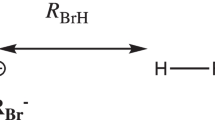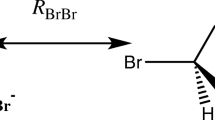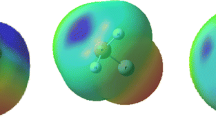Abstract
MP2/aug-cc-pVTZ calculations were performed for complexes linked by hydrogen bonds. Three types of proton donating species were taken into account: H2O, CCl3H, and H3O+. These calculations are supported by the natural bond orbital (NBO) method and the quantum theory of atoms in molecules (QTAIM) approach. Numerous correlations between parameters of H-bonded systems were found. The most important are those which show the response of the system on the H-bond formation; for example, the increase of polarization of the A-H bond correlates with the strength of the hydrogen bond. Similar relationships were found for the σ-hole bonds while the π-hole bonds do not follow the trends known for the hydrogen bonds.

Hydrogen bonds and other interactions as a response to protect doublet/octet electron structureᅟ






Similar content being viewed by others
References
Jeffrey GA, Saenger W (1991) Hydrogen bonding in biological structures. Springer, Berlin
Jeffrey GA (1997) An introduction to hydrogen bonding. Oxford University Press, New York
Desiraju GR, Steiner T (1999) The weak hydrogen bond in structural chemistry and biology. Oxford University Press, New York
Nishio M, Hirota M, Umezawa Y (1998) The CH/π interaction: evidence, nature and consequences. Wiley-VCH, New York
Scheiner S (1997) Hydrogen bonding: a theoretical perspective. Oxford University Press, New York
Grabowski SJ (ed) (2006) Hydrogen bonding — new insights. Springer, Dordrecht
Sobczyk L, Grabowski SJ, Krygowski TM (2005) Interrelation between H-bond and pi-electron delocalization. Chem Rev 105:3513–3560
Perrin CL, Nielson JB (1997) Strong hydrogen bonds in chemistry and biology. Annu Rev Phys Chem 48:511–544
Murray JS, Lane P, Politzer P (2009) Expansion of the σ-hole concept. J Mol Model 15:723–729
Clark T, Hennemann M, Murray JS, Politzer P (2007) Halogen bonding: the σ-hole. J Mol Model 13:291–296
Politzer P, Murray JS, Concha MC (2007) Halogen bonding and the design of new materials: organic bromides, chlorides and perhaps even fluorides as donors. J Mol Model 13:643–650
Politzer P, Murray JS, Clark T (2010) Halogen bonding: an electrostatically-driven highly directional noncovalent interaction. Phys Chem Chem Phys 12:7748–7757
Politzer P, Murray JS (2013) Halogen bonding: an interim discussion. ChemPhysChem 14:2145–2151
Murray JS, Riley KE, Politzer P, Clark T (2010) Directional weak Intermolecular Interactions: σ-hole bonding. Aust J Chem 63:1598–1607
Bundhun A, Ramasami P, Murray JS, Politzer P (2013) Trends in σ-hole strengths and interactions of F3MX molecules (M = C, Si, Ge and X = F, cl, Br, I). J Mol Model 19:2739–2746
Clark T (2013) σ-Holes. WIREs Comput Mol Sci 3:13–20
Bauzá A, Frontera A (2015) Aerogen bonding interaction: a new supramolecular force? Angew Chem Int Ed 54:7340–7343
Politzer P, Murray JS, Clark T (2013) Halogen bonding and other σ-hole interactions: a perspective. Phys Chem Chem Phys 15:11178–11189
Murray JS, Lane P, Clark T, Riley KE, Politzer P (2012) σ-holes, π-holes and electrostatically-driven interactions. J Mol Model 18:541–548
Grabowski SJ (2014) Boron and other triel Lewis acid centers: from Hypovalency to Hypervalency. ChemPhysChem 15:2985–2993
Grabowski SJ (2015) π-hole bonds: boron and aluminum Lewis acid centers. ChemPhysChem 16:1470–1479
Grabowski SJ (2015) Triel bonds, π-hole-π-electrons interactions in complexes of boron and aluminium trihalides and trihydrides with acetylene and ethylene. Molecules 20:11297–11316
Grabowski SJ (2017) Triel bonds – complexes of boron and aluminum trihalides and trihydrides with benzene. Struct Chem 28:1163–1171
Grabowski SJ (2017) Two faces of triel bonds in boron Trihalide complexes. J Comput Chem. https://doi.org/10.1002/jcc.25056
Vinh-Son N, Swinnen S, Matus MH, Nguyen MT, Dixon DA (2009) The effect of the NH2 substituent on NH3: hydrazine as an alternative for ammonia in hydrogen release in the presence of boranes and alanes. Phys Chem Chem Phys 11:6339–6344
Miranda CR, Ceder G (2007) Ab initio investigation of ammonia-borane complexes for hydrogen storage. J Chem Phys 126:184703
Keaton RJ, Blacquiere JM, Baker RT (2007) Base metal catalyzed dehydrogenation of ammonia−borane for chemical hydrogen storage. J Am Chem Soc 129:1844–1845
Staubitz A, Besora M, Harvey JN, Manners I (2008) Computational analysis of amine-borane adducts as potential hydrogen storage materials with reversible hydrogen uptake. Inorg Chem 47:5910–5918
Grabowski SJ (2011) Halogen bond and its counterparts: Bent’s rule explains the formation of nonbonding interactions. J Phys Chem A 115:12340–12347
Grabowski SJ (2012) QTAIM characteristics of halogen bond and related interactions. J Phys Chem A 116:1838–1845
Grabowski SJ (2017) Hydrogen bonds, and σ-hole and π-hole bonds – mechanisms protecting doublet and octet electron structures. Phys Chem Chem Phys 19:29742–29759
Weinhold F, Landis C (2005) Valency and bonding, a natural bond orbital donor – acceptor perspective. Cambridge University Press, Cambridge
Reed AE, Curtiss LA, Weinhold F (1988) Intermolecular interactions from a natural bond orbital, donor-acceptor viewpoint. Chem Rev 88:899–926
Alabugin IV, Manoharan M, Peabody S, Weinhold F (2003) Electronic basis of improper hydrogen bonding: a subtle balance of Hyperconjugation and Rehybridization. J Am Chem Soc 125:5973–5987
Weinhold F, Klein R (2012) What is a hydrogen bond? Mutually consistent theoretical and experimental criteria for characterizing H-bonding interactions. Mol Phys 110:565–579
Grabowski SJ (2013) Non-covalent interactions – QTAIM and NBO analysis. J Mol Model 19:4713–4721
Frisch MJ, Trucks GW, Schlegel HB et al (2009) Gaussian 09, revision A.1. Gaussian Inc, Wallingford
Møller C, Plesset MS (1934) Note on an approximation treatment for many-electron systems. Phys Rev 46:618–622
Dunning Jr TH (1989) Gaussian basis sets for use in correlated molecular calculations. I. The atoms boron through neon and hydrogen. J Chem Phys 90:1007–1023
Piela L (2007) Ideas of quantum chemistry. Elsevier, Amsterdam, pp 684–691
Grabowski SJ, Sokalski WA (2005) Different types of hydrogen bonds: correlation analysis of interaction energy components. J Phys Org Chem 18:779–784
Boys SF, Bernardi F (1970) The calculation of small molecular interactions by the differences of separate total energies. Some procedures with reduced errors. Mol Phys 19:553–561
Bader RFW (1985) Atoms in molecules. Acc Chem Res 18:9–15
Bader RFW (1990) Atoms in molecules, a quantum theory. Oxford University Press, Oxford
Popelier P (2000) Atoms in molecules. An introduction. Prentice Hall, Upper Saddle River
Matta C, Boyd RJ (eds) (2007) Quantum theory of atoms in molecules: recent progress in theory and application. Wiley-VCH, Weinheim
Todd A, Keith TK (2011) AIMAll (Version 11.08.23). Gristmill Software, Overland Park aim.tkgristmill.com
Hobza P, Havlas Z (2000) Blue-shifting hydrogen bonds. Chem Rev 100:4253–4264 (and references cited therein)
Grabowski SJ, Ugalde JM (2010) Bond paths show preferable interactions: ab initio and QTAIM studies on the X-H· · ·π hydrogen bond. J Phys Chem A 114:7223–7229
Grabowski SJ (2011) What is the covalency of hydrogen bonding? Chem Rev 11:2597–2625
Platts JA, Howard ST, Bracke BRF (1996) Directionality of hydrogen bonds to sulfur and oxygen. J Am Chem Soc 118:2726–2733
Cremer D, Kraka E (1984) A description of the chemical-bond in terms of local properties of electrodensity and energy. Croat Chem Acta 57:1259–1281
Jenkins S, Morrison I (2000) The chemical character of the intermolecular bonds of seven phases of ice as revealed by ab initio calculation of electron densities. Chem Phys Lett 317:97–102
Crabtree RH (2017) Hypervalency, secondary bonding and hydrogen bonding: silbinds under the skin. Chem Soc Rev 46:1720–1729
Coulson CA (1952) Valence. Oxford University Press, Oxford
Grabowski SJ, Sokalski WA (2017) Are various σ-hole bonds steered by the same mechanisms? ChemPhysChem 18:1569–1577
Grabowski SJ (2014) Tetrel bond - σ-hole bond as a preliminary stage of the SN2 reaction. Phys Chem Chem Phys 16:1824–1834
Acknowledgments
Financial support comes from Eusko Jaurlaritza (GIC IT-588-13) and the Spanish Government MINECO/FEDER (CTQ2016-80955). Technical and human support provided by Informatikako Zerbitzu Orokora - Servicio General de Informática de la Universidad del País Vasco (SGI/IZO-SGIker UPV/EHU), Ministerio de Ciencia e Innovación (MICINN), Gobierno Vasco Eusko Jaurlanitza (GV/EJ), European Social Fund (ESF) is gratefully acknowledged.
Author information
Authors and Affiliations
Corresponding author
Additional information
Dedicated to Professor Peter Politzer on the occasion of his 80th birthday
This paper belongs to Topical Collection P. Politzer 80th Birthday Festschrift
Electronic supplementary material
ESM 1
(DOC 183 kb)
Rights and permissions
About this article
Cite this article
Grabowski, S.J. Hydrogen bonds and other interactions as a response to protect doublet/octet electron structure. J Mol Model 24, 38 (2018). https://doi.org/10.1007/s00894-017-3569-4
Received:
Accepted:
Published:
DOI: https://doi.org/10.1007/s00894-017-3569-4




